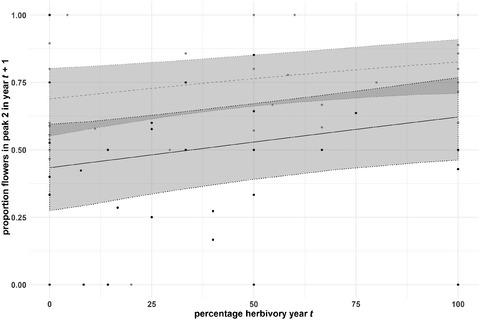Our official English website, www.x-mol.net, welcomes your
feedback! (Note: you will need to create a separate account there.)
Induced phenological avoidance: A neglected defense mechanism against seed predation in plants
Journal of Ecology ( IF 5.3 ) Pub Date : 2019-12-26 , DOI: 10.1111/1365-2745.13325 Bram K. Sercu 1 , Iris Moeneclaey 1, 2 , Dries Bonte 1 , Lander Baeten 2
中文翻译:

诱导物候回避:植物对种子捕食的防御机制被忽略
更新日期:2019-12-26
Journal of Ecology ( IF 5.3 ) Pub Date : 2019-12-26 , DOI: 10.1111/1365-2745.13325 Bram K. Sercu 1 , Iris Moeneclaey 1, 2 , Dries Bonte 1 , Lander Baeten 2
Affiliation

|
- Flowering phenology is an important life‐history trait affecting plant reproductive performance and is influenced by various abiotic and biotic factors. Pre‐dispersal seed predation and pollination are expected to impose counteracting selection pressure on flowering phenology, with pre‐dispersal seed predation expected to favour off‐peak flowering and pollination to favour synchronous flowering.
- Here we studied the effect of pre‐dispersal seed predation by the beetle Byturus ochraceus, a specialist seed herbivore, on the flowering phenology of Geum urbanum. This forest understorey plant species is self‐pollinating, so that the influence of seed predation can be studied independent from pollination. We measured in detail the timing and predation rate of individual flowers during two consecutive years in more than 60 individuals. We tested the hypotheses that pre‐dispersal seed predation exerts selection for within‐season compensatory flowering as well as for induced phenological avoidance in the following season.
- We found no indication for compensatory flowering within a growing season, but plants that experienced predation shifted their flowers to the end of the flowering season the subsequent year. This induced phenological avoidance points to a plastic response to pre‐dispersal seed predation that may be adaptive. Importantly, the delay in flower production came at a cost, since flowers later in the season had a reduced seed output, presumably because of increasing light limitation following forest canopy closure.
- Synthesis. Herbivory by specialist enemies can cause serious fitness decline in hosts. We here show that induced shifts in phenology can form an important defense strategy against pre‐dispersal seed predation. The induced mismatches between herbivore and host phenology are anticipated to be adaptive when herbivory is predictable across successive flowering periods.
中文翻译:

诱导物候回避:植物对种子捕食的防御机制被忽略
- 开花物候是影响植物繁殖性能的重要生命史特征,并受多种非生物和生物因素的影响。预计散前种子的捕食和授粉将对开花物候施加选择压力,而散前种子的捕食则有利于非高峰开花,授粉则有利于同步开花。
- 在这里,我们研究了甲虫Byturus ochraceus(一种专门的种子食草动物)对种子的预分散对捕食Geum urbanum的开花物候的影响。这种林下植物是自花授粉的,因此可以独立于授粉来研究种子捕食的影响。我们详细测量了连续两年中60多个个体中单个花朵的时间和捕食率。我们检验了以下假设,即散播前的种子捕食对季节内补偿性开花以及在接下来的季节中引起的物候回避产生选择作用。
- 我们没有发现在生长季节内进行补偿性开花的迹象,但是经历了捕食的植物将其花朵转移到了第二年开花季节的末尾。这种诱发的物候回避现象表明对散播前种子捕食的可塑性响应可能是适应性的。重要的是,花卉生产的延迟是有代价的,因为本季节晚些时候的花卉种子的产量减少了,这大概是由于森林冠层关闭后光照限制的增加。
- 综合。专业敌人的食草会导致宿主的严重健康下降。我们在这里表明,物候学上的诱导转变可以形成针对预分散种子捕食的重要防御策略。当在连续开花期可预测食草时,预计食草动物和宿主物候之间的诱导失配是适应性的。











































 京公网安备 11010802027423号
京公网安备 11010802027423号